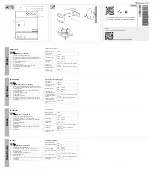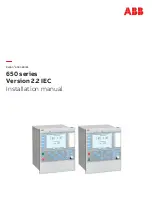
Powered by Safety
®
29
Installation
01.4IB.65131
inserting the secondary disconnect
override device in the secondary
disconnect receptacle. This device must be
removed after testing and before the circuit
breaker is inserted into the compartment.
The mechanical operation of the circuit
breaker is checked by inserting the manual
charging handle into the manual charging
crank and pushing down until a metallic
click is heard. (This indicates that the
holding pawl has dropped into place on the
ratchet wheel). Lift the handle up and then
depress. The procedure is repeated until
the spring charge indicator indicates
“CLOSING SPRING CHARGED”.
This
requires about 60 operations of the handle.
Remove the handle.
The MOC actuator is exposed when the circuit
breaker is outside the metal-clad switchgear
and can cause serious injury if the test
personnel or any object is in the travel path
during operation. Care should be taken to
isolate the MOC side of the circuit breaker for
these tests.
!
CAUTION
Push the manual close operator
inward and the circuit breaker
will close. The circuit breaker open/closed
indicator located above the manual
close operator will now display
“BREAKER CLOSED”.
Push the manual
trip operator
inward, which is
located at the top of the escutcheon and
the circuit breaker open/closed indicator
will now display
“BREAKER OPEN”.
3) Control Voltage Insulation Integrity
If the user wishes to check the insulation
integrity of the control circuit, it may be
done with a 500V or 1000V insulation
resistance tester or with an AC high
potential tester. The AC high potential
test should be made at 1125V, 50 or
60 Hz for one minute. The charging motor
and CBM (
), if present, must be
disconnected prior to testing the control
circuit. The charging motor itself may be
similarly tested at a voltage not to exceed
675V, 50 or 60 Hz. Be sure to remove any
test jumpers and reconnect the charging
motor when the tests are complete.
Remove all grounding conductors applied
for this test before placing the circuit breaker
back into service.
!
CAUTION
4) Mechanical Operation Check
Keep personnel, tools, and other objects
clear of mechanisms that are to be operated
or released. Failure to do so may result
in equipment damage and/or minor or
moderate injury.
!
CAUTION
The contacts of the vacuum interrupter
during normal operation cannot be closed
unless the secondary disconnect plug is
inserted into the secondary disconnect
receptacle. To check the circuit breaker
outside of the circuit breaker compartment,
it is necessary to simulate the connection
of secondary disconnecting device by













































